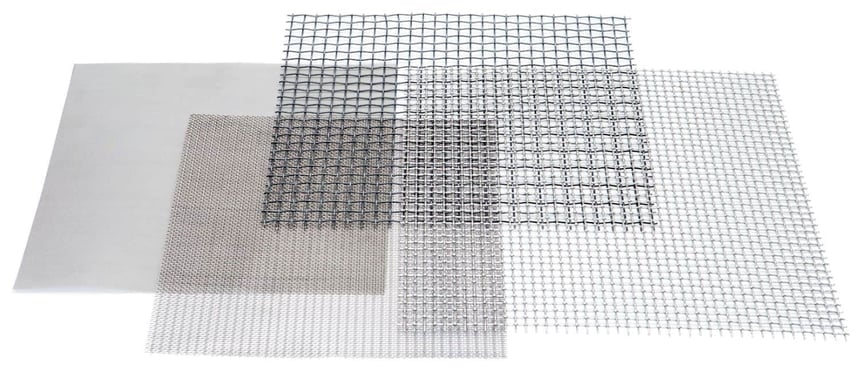Woven Wire Mesh: Why Precision Matters
When it comes to woven wire mesh, precision is the unsung hero that determines whether it performs or fails under pressure. Imagine you are a pharmaceutical manufacturer that relies on best-in-class particle retention.
The smallest deviations in aperture size can ultimately render entire batches contaminated. For a lot of industries, precision in woven wire mesh isn’t just a want—it’s a need.
But what really defines precision in woven wire mesh? How is it achieved? What are the side effects of imprecise mesh?
Here at W.S. Tyler, precision has been the foundation of everything we do for over 150 years. Our mission is simple: Engineer high-precision wire mesh solutions that adhere to the strictest of tolerances.
With that, we wrote the following article to break down why precision matters when using woven wire mesh. You will learn:
- The definition of woven wire mesh
- What precision means when talking about woven wire mesh
- How precision woven wire mesh is achieved
- The consequences of using imprecise woven wire mesh
- How to ensure your woven wire mesh is precise
What Is Woven Wire Mesh?
Woven wire mesh is a methodically crafted metal fabric comprised of interwoven wires that are oriented in a precise grid pattern. Using centuries-old weaving techniques, each wire mesh weave is outfitted with uniform mesh openings that promote controlled particle retention, filtration, separation, as well as structural integrity.

Now, over the years, the versatility of woven wire mesh has grown immensely. This is mainly due to the level of customization that it offers.
Parameters such as wire diameter, mesh count, alloy, and weave type can all be tailored to deliver best-in-class performance. That being said, each element of your mesh should be executed with high precision to ensure compliance with strict tolerances and efficiency requirements.
What Is Precision in Woven Wire Mesh?
In the world of woven wire mesh, precision refers to the exactness of four key elements: the mesh openings, wire diameter, weave uniformity, and dimensional stability. All these factors play into the filtration, performance, separation, and structural capabilities of wire mesh.
Achieving the level of precision needed to produce industry-leading performance requires high-tolerance weaving techniques that are heavily monitored. That being said, factors such as weaving accuracy, material selection, and post-weave calibration all play into the precision and, ultimately, the performance of your mesh.
Considering that even the smallest inconsistencies in your mesh can lead to clogging, contamination, and operational inefficiencies, tight tolerances and rigorous quality control are of the utmost importance when weaving wire mesh.
When precise woven wire mesh is used, consistent particle retention, optimal flow rates, and peak mechanical strength work in conjunction to minimize performance and quality deviations.
How To Achieve a Precise Woven Wire Mesh
Achieving a precise woven wire mesh falls onto three things: a high-tolerance manufacturing process, methodical material selection, and rigorous quality control. That said, the process of weaving highly precise wire mesh starts with selecting a suitable alloy.
In most cases, wire mesh is woven using a 300 series stainless steel; however, other high-grade alloys like brass, Hastelloy, etc., can be used.
Once the material is selected, advanced weaving technologies must be implemented to achieve uniform wire placement and exact mesh openings. This includes the use of precision looms and controlled tensioning systems.
To further enhance mesh consistency and structural integrity once woven, post-weaving treatments like calendering and heat treatment can be applied to wire mesh.
Why is heat treatment vital to the woven wire mesh industry? Find out in the article below:
Measuring Precision
The precision of woven wire mesh can be verified using either laser measurement technology, digital imaging, or by cross-referencing compliance with ISO and ASTM standards. A reliable verification process will work to ensure micron levels are accurate, ensuring peak performance in filtration, separation, and particle retention applications.
The Consequences of Using Imprecise Woven Wire Mesh
The use of imprecise woven wire mesh can result in considerable operational failures, increased expenses, and undesirable inefficiencies. For filtration and separation applications specifically, the inconsistent mesh openings associated with imprecise mesh can lead to particle leakage or clogging.
This can ultimately result in concerning product contamination, recalls, and costly downtime.
Furthermore, structural inconsistencies can render the durability of your mesh weak. This can leave you with a weave that is vulnerable to premature wear, tearing, or failure.
This is particularly true in high-stress applications.
It should also be noted that imprecise wire mesh can increase fluid resistance in various filter systems, which promotes reduced flow rates that create a higher demand for energy consumption.
Put simply, using wire mesh that was woven without strict precision standards can introduce higher maintenance costs, issues in terms of complying with industry standards, and, more importantly, potential safety hazards. In other words, high-tolerance, quality-assured wire mesh is a must to maintain a safe and efficient operation.
How Do I Know if My Woven Wire Mesh Is Precise?
To ensure your mesh is precise, you must analyze the material quality, manufacturing standards, and the overall expertise of the supplier. You will want to start by selecting a wire mesh supplier that follows ISO, ASTM, or other trusted industry standards to guarantee the mesh is woven under tight tolerances and quality consistency.
You must also assess the weaving process to verify that high-tolerance looms are in place to weave uniform mesh openings, wire diameters, and weave stability. To verify, you can request the technical specifications, including the mesh count, mesh thickness, and percentage of open area.
Looking for more information on the percentage of open area and its impact on wire mesh performance? Read the article below:
It will prove beneficial to insist on quality control measures like laser measurement and digital imaging. This will allow you to verify accuracy at the micron level.
But all this is for naught if you fail to choose a supplier that offers a catalog of customization options that meet the performance requirements of your process. You should seek a wire mesh partner that carries a proven track record in precision engineering, reliable performance, efficiency, and on-time delivery.
Woven Wire Mesh Tailored to the Materials You Work With
Precision in woven wire mesh is more than just manufacturing accuracy—it’s ensuring your mesh perfectly matches the particles it’s designed to handle. Whether you’re separating industrial material or extruding plastic, choosing a suitable mesh specification is key.
No matter what industry you work in, your mesh must be engineered to interact with the size, shape, and behaviors of your particles.
At W.S. Tyler, we understand the importance of precision and that it starts with understanding the unique characteristics of the material you work with. As even a small miscalculation can hinder the performance of your system, our mission is simple: craft industry-leading solutions that enhance efficiency, reliability, and performance.
For more information about how you can tailor your wire mesh to the characteristics of your particles, read the article below:
About Ronnie Brown
Ronnie is the Content Writer for W.S. Tyler and has four years of experience as a professional writer. He strives to expand his knowledge on all things particle analysis and woven wire mesh to leverage his exceptional writing and graphic design skills, creating a one-of-a-kind experience for customers.




